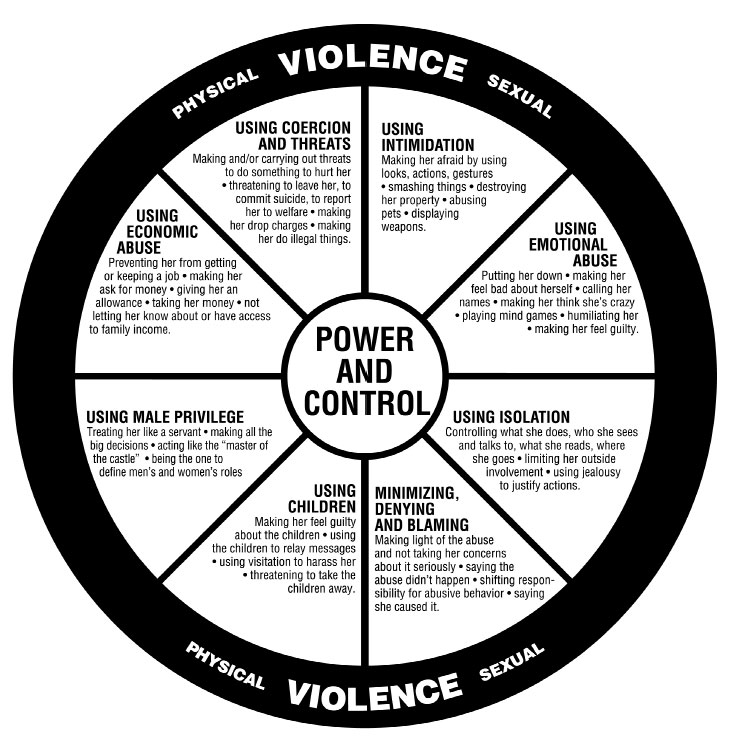About Domestic Abuse
Domestic violence can also be referred to as: spousal abuse, woman abuse, family abuse, gender-based violence, intimate partner violence and violence against women. If you have or are experiencing domestic violence, see our Getting Help page for information on resources in our community.
What is Domestic Abuse?
There are many definitions of domestic violence – it includes, but is not limited to, the use of actual or threatened physical, psychological or sexual force in an intimate relationship (e.g. marital, common-law, same-sex, dating). Abusive partners use these tactics to exercise power and control over their victim and it can happen once or it may occur in a repeated and escalating pattern over a period of months or years. It can happen during a relationship or after it has ended.
As described by the United Nation’s Declaration on the Elimination of Violence Against Women, violence against women stems from inequality between men and woman and the ongoing discrimination against women. The Declaration also states that some women are more vulnerable to violence “such as women belonging to minority groups, indigenous women, refugee women, migrant women, women living in rural or remote communities, destitute women, women in institutions or in detention, female children, women with disabilities, elderly women and women in situations of armed conflict”.
The Different Forms of Abuse
Physical abuse or the threat of physical abuse is against the law. It can cause an injury or put a person at risk of being injured and can include pushing, hitting, shaking, beating, choking, biting, burning, kicking, confinement or assaulting with a weapon. Even if the assault appears minor, it should be taken seriously as it may be the beginning of a pattern of assault that becomes more serious and happens more often.
Sexual abuse or the threat of sexual abuse can occur in an intimate relationship although many women are reluctant to acknowledge this form of abuse. It is against the law and includes all forms of sexual assault, sexual harassment or sexual exploitation. Forcing someone to participate in unwanted, unsafe or degrading sexual activity again demonstrates the power and control the abuser is seeking and puts women in extreme jeopardy of their immediate safety along with possible health issues that may develop later.
Psychological and emotional abuse is used to control a person and make them afraid. It includes verbal attacks such as yelling, screaming and name-calling, using criticism, threatening a person or their loved ones, social isolation, intimidation, stalking, damaging their possessions and threatening to harm them and/or harm their pets.
Financial abuse or the control of money is another serious aspect of woman abuse. Having no access to money, not being allowed to work or to have to turn all earnings or social assistance over to the abuser is a major factor in keeping women from leaving their abuser. Financial abuse can also occur in affluent as well as low-income families.
The Power and Control Wheel
The following model shows how power and control tactics, not actual physical harm or beatings, demonstrate the core of woman abuse as perpetrated by men.

Why Do Women Stay?
Is important to understand why women stay in abusive relationships, why they often keep returning to those same abusive relationships and why it takes women so long to leave. By understanding, we will not blame women but will support them in every way possible, so that they can live with their children in a violence-free environment. The following outlines some of those reasons:
- They love their partner, they just want the abuse to stop.
- They think the abuse will stop.
- They do not want to take their children away from their father.
- They think they are the cause of the abuse and keep trying to not upset or anger their partner.
- They don’t have the financial resources to leave and know that they will likely face severe hardships.
- They have been so isolated from family and friends they don’t know where to turn for help and assistance.
- Their health and self-esteem has been so affected that they don’t have the strength to leave.
- They are afraid to leave because of threats made in case they do.
- They are afraid for the lives of their children or other family members.
- There are no housing resources.
- They are afraid their children will be taken away from them.
- They have no money to pay for legal resources.
- They are embarrassed that this is happening in their family or relationship.
- It is important to keep the “family secret.”
- they are not believed when they have told a friend, physician, family member, etc.
- Their religious beliefs prevent them from leaving.
- The abuser has promised to change and is remorseful for what he has done (often called the honeymoon phase of the cycle of violence).
- They are afraid they will be deported if their abuser is their sponsor.
- They are dependent on their abuser for care.
- They understand they are at greatest risk when they attempt to leave (it has been estimated that the danger to a victim increases by 70% when she attempts to leave, as the abuser escalates his use of violence when he begins to lose control).
- Social and justice systems may have been unresponsive, insensitive or ineffective in the past.
- They may have to leave their community to be safe, disrupting schooling and employment.
